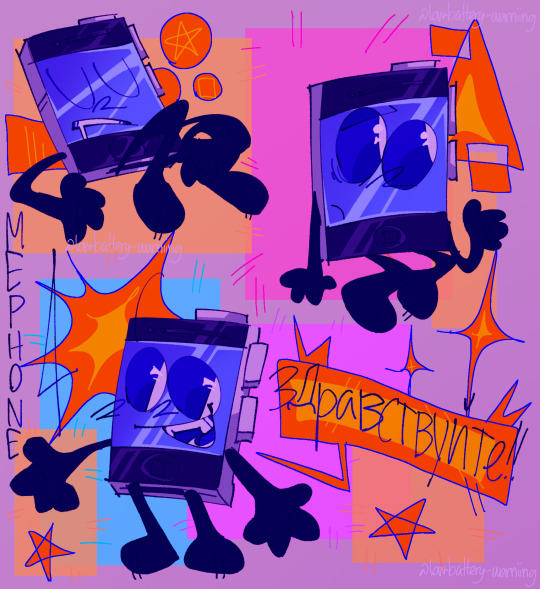skip / leech || any pronouns || i do art and i like robots :)
Don't wanna be here? Send us removal request.
Text
REBLOG IF YOUR BLOG IS A SAFE SPACE FOR AROMANTIC PEOPLE AND IF YOU THINK THEY ARE VALID
I want to see how many people actually are willing to say this and not just act like it
30K notes
·
View notes
Text
why would you do this to me
esoteric form of roleplay where instead of actually roleplaying you just make up characters together and discuss in abstract how they'd interact and how their story would go
86K notes
·
View notes
Text
i have many object show mutuals actually and i think its so fun. ill be scrolling my dash and see a post like “why toilet paper is ptsd coded” and be like okayy
19 notes
·
View notes
Text
If you could instantly be granted fluency in 5 languages—not taking away your existing language proficiency in any way, solely a gain—what 5 would you choose?
238K notes
·
View notes
Text

mephone color test from last night
havent drawn this guy in a while
71 notes
·
View notes
Text
going on pinterest and commenting “hmm… i find this really.. pinteresting…!” on every single post i see
62K notes
·
View notes
Text

*lures you in* come, look at my dredge seawings …. Pspspspsps
so the majour changes are they’re more stony/earthy coloured because nobody goes in the water. for reasons. + adults get their gills slashed!
68 notes
·
View notes
Text
Tips Collection for AD(H)D && Autism
Context: If you’ve arrived here via the link I shared in the Game, welcome! For those who found this page another way, this blog is a curated collection of strategies for managing AD(H)D && Autism. While not every strategy will work for everyone, I’m sharing approaches that have been effective for my brother and me. Both of us are formally diagnosed (autism && AD(H)D)—me with low support needs (lsn), and my brother with medium to high support needs (msn/hsn).
Additionally, I’m part of a relatively large neurodivergent friend-circle (specifically focusing on Autism and AD(H)D for the context here, although my friends extend beyond that), including both formally diagnosed and self-diagnosed friends. I feel fortunate to work in an industry that naturally attracts a significant number of neurodivergent individuals, providing me with valuable access to this vibrant and diverse information.
My hope is that you’ll find this resource helpful and can choose the strategies that best suit your unique support needs or that it helps you support a loved one. None of this is a one-size-fits-all solution, which is why I created a Game to draw attention toward this issue. However, some of these strategies might help ease the stress of dealing with overstimulation or just navigating the unique challenges associated with a particular neurotype, even if just a little.
CLEANING: – Dishwasher over handwashing. If possible, always use the dishwasher instead of handwashing. It saves time and minimizes the physical discomfort of touching dirty dishes.
– Wear rubber gloves. I wear gloves to avoid touching dirty stuff, as it’s a huge sensory discomfort for me. This helps with cleaning.
– Use paper towels. Paper towels are my go-to for cleaning. They’re easy to throw away after use, and I use wet ones for cleaning different surfaces to avoid the mess and sensory-hell of sponges.
– When I’m low on energy, I use disposable plates and cutlery to avoid doing dishes. This helps when I don’t have the energy to clean or wash.
– For food waste and things that could mold, use a container with a lid. It prevents the smell from getting worse, especially if you forget about it for a day or two.
– Use a cordless vacuum with a simple charging station. Fewer steps make it easier to store and use, and it’s less of a hassle to get started.
– A steamer is much easier than mopping. It’s quicker, better for storage, and involves fewer steps.
– I keep ‘miscellaneous buckets’—places where I throw things that don’t have a spot yet or I can’t clean up right now. Later, when I have energy, I sit down and sort them out. Throwing it all into a bucket keeps the space looking tidier and everything in one place.
– Put garbage containers in places where trash tends to pile up. This reduces the effort of having to walk somewhere to throw something away and helps manage clutter.
– Sometimes, I’ll call a friend over to help motivate me to clean. The anxiety of someone coming over pushes me to tidy up quickly.
– Start from the ground up and create a system where you can easily access the items you need, like using drawer organizers or a box system that allows you to pull out what you need without having to move anything on top. Design your space to be as accessible as possible. Keep things in sight by using transparent boxes or labeling every door to help you know where everything is. Your AD(H)D will forget something exists if it can’t see it, as it struggles with object permanence. So, keep things where they’re visible. Especially food that can rot.
– If you're concerned about the environment, remember that the majority of waste comes from big companies (or countries like China and America who are not climate friendly) and billionaires taking joyrides into space. That plastic cup isn't going to change the world. You're disabled—shut the fuck up and prioritize accommodating yourself.
DOCTORS/MEDICAL ASSESSMENTS: – As a woman (trans, cis, or if you’re afab; generally the full spectrum of anything that is even remotely ‘perceived’ as fem-representing), your pain is often dismissed. What helped me was bringing my partner along, as doctors tend to pay more attention when it comes from a man—especially when it's noticeable enough for a witness to point it out. Having a witness can make them take you more seriously. If you go alone, tell them someone else sent you and told you to get it checked out, again making sure it's clear that someone else noticed the issue.
– If they still dismiss you, ask the doctor to document it in your file—that you came to see them for a specific issue and were turned away. This makes the doctor liable if something happens later and creates a paper trail.
– Doctors react more to your facial expressions and tone of voice than to what you actually say.
– Pain scale: 1-10. If you’re about to pass out and want to scream and can’t articulate yourself anymore, that's a 9-10. Slightly below that, where you feel like you’re losing it, is a 7-8. Below a 5, they usually won’t bother. Pain really becomes problematic around a 6, so that’s my starting point on the scale. You do not have to be exact, just name a number above 5.
– Much of the medical knowledge surrounding autism and ADHD is severely outdated, including terms like 'functioning labels' and even 'Asperger's.' Terms like 'high functioning' and 'low functioning' were used by the Nazis to determine whether someone would be killed (low functioning) or spared (high functioning). A more accurate term is 'low and high support needs,' as it focuses on the level of support required. The levels 1, 2, and 3 are often misunderstood, as they actually refer to the level of support needed, not the individual's functioning level.
Don’t trust anyone who wants to put you, or a loved one, into ABA therapy. It's essentially dog training—forced conditioning. It aims to make you conform to societal norms by gaslighting you, rather than helping you. For me, it pushed me closer to suicide than anything else because it stripped away natural autistic coping mechanisms that were helping me. I was forbidden from accessing my special interests or retreating into my head by these therapists, which caused immense harm.
A special interest is often an autistic person’s way of trying to connect with others through something important to them. It’s not considered harmful if a neurotypical child is obsessed with monster trucks, but if an autistic child has a special interest, it’s seen as a distraction. Instead, consider occupational therapy, motor skills therapy, speech therapy, and finding a therapist who understands both autism and AD(H)D, not one who tries to 'train it away.' ABA doesn’t work—it slowly kills the individual. Do not. – If you're looking for helpful resources online, search for tags like #ActuallyAutistic, #ActuallyADHD or #Neurodivergent. These are adults who live with the conditions and can provide insight into what it’s truly like from the inside. Gold and red represent autism and AD(H)D, respectively, while the rainbow infinity symbol represents neurodiversity. Avoid Autism Speaks—they actively support euthanization and are harmful. The puzzle piece symbol and the color blue are also associated with harmful organizations and ideas, so it's best to steer clear of anything using those.
DRINKING: – Use separate canisters for different drinks: I have a different outdoor canister for each drink type—coffee, tea, water, and flavored water—because I’m terrible at cleaning them right away. Mixing flavors in the material is awful for me since my sense of taste is extremely sharp. I can even tell if food is starting to spoil before most people notice. To avoid mixing flavors in your drink containers, dedicate one canister for each specific taste. This keeps the flavors from getting stuck in the material, which can make sensory issues worse.
– Another trick I use is buying large water bottles and slapping some syrup in them. I struggle with drinking plain water because it doesn't quite satisfy my thirst, so I trick my brain by adding flavor, and that somehow does the magic. Plus, you don't need to clean those bottles, if cleaning is an issue. You can just throw them out.
– Clean containers with dental tabs. Bacteria are not a flavor, and cleaning that thing is very, very important. If you struggle to clean containers immediately, use dental tabs. Just throw one or two in with water, shake it up, and let it sit. When you return, it’ll be clean, even if you leave it for a while.
– I tricked myself into drinking more by preparing a 2-liter canister of tea with a straw. The straw and one big container make it easier to keep track of my hydration without thinking about it constantly. And I suck that bitch away if it has a straw. Don’t ask me why. I can inhale that entire canister if it has a straw, but I will barely get a sip in if I drink regularly. It’s a weird quirk, but maybe that helps someone with their drinking habits.
– Make drinks fancy. In the summer, I prepare drinks like blueberry tea with honey or syrup, rosemary, lemon slices, and frozen blueberries. The filter I have keeps solids out of the drink but makes it visually appealing. My AD(H)D loves when things are extra and fancy, so I get creative with my drinks to make the process more fun and engaging. AD(H)D thrives on excitement and novelty, so I make my drinks extravagant—glitter, colorful garnishes, and other flashy touches. The more visually engaging, the better my AD(H)D will pay attention and get motivated to drink more. Fancy glasses and cups also do the trick.
EATING/FOOD: – Keep food that feels ‘safe’ for you to eat on hand—something simple and comforting that you can tolerate without stress.
– Stock foods that are fast and simple to prepare. This helps with time calculation issues, low energy, or forgetting to eat.
– Always carry dextrose. It provides a fast blood sugar boost if you realize you haven’t eaten for days and are at risk of fainting or hospitalization (a situation I’ve faced too often).
It can also be lifesaving for others, like when I was at the station and had a mute, diabetic person collapse into my arms. I could offer first aid, because I had dextrose on hand.
– If your brain allows it, try introducing one healthy ingredient at a time into your meals to slowly broaden the variety of foods you can eat. Or explore similar flavors. My AD(H)D often contrasts with my autism in terms of rigidity, as it thrives on stimming with intense flavors and enjoys trying new things.
– If certain textures/flavors overwhelm you (for me, it’s especially fruit and veggies), blending them into a smoothie creates a uniform taste and texture that’s easier to handle. Smoothies offer an easier way to consume healthy food, and sometimes making a few adjustments can turn foods that were once unbearable into something enjoyable. For instance, I can't eat bananas—the texture and taste make me gag, though I'm not sure why, since I can eat them in other forms like banana bread. However, I love them in smoothies with a bit of milk, honey, and cinnamon.
– Another tip that might help is cooking vegetables instead of eating them raw, although it may destroy some of the nutrients. I personally have a fear of certain vegetables because of past childhood experiences where I found insects or insect larvae hidden inside or between them. To lessen this anxiety, I prefer cooking the vegetables or blending them in a mixer, as the heat from cooking will kill any potential pests and make them less likely to be noticeable. This makes it easier for me to eat vegetables without the fear of… unexpected surprises.
– I generally throw a lot of ingredients into my mixer—it’s a game-changer for simplifying cooking. With the right attachment, a mixer can cut onions for you, sparing your eyes and saving time. I let my mixer handle all the veggie and fruit chopping, making meal prep faster and much less overwhelming. – Pre-cut and freeze your food items—it’s a simple way to avoid the hassle of products spoiling in your fridge or pantry because you forgot about it. I keep portioned bags of vegetables, stock up on frozen fruits, and prepare meals when I have the energy, so they’re ready to go for days when I don’t. This approach saves time, reduces waste, and ensures you always have something convenient and nutritious on hand, even when you’re low on executive energy. When you go shopping (or are already doing another task), you build momentum, and you can keep it going by immediately prepping—cutting everything up and portioning the food.
– I’d advise against buying salad, vegetables, or fruits in pre-packaged plastic bags from the store, as they can be a breeding ground for bacteria. While it may be convenient, it comes with certain health risks.
– Taste manipulation. Too Salty? Add a few drops of lemon juice—it balances the flavor without being overwhelming, because it basically adds another canvas layer to the ‘taste picture’, if that makes sense. Too Bland? A small pinch of salt enhances the taste without overpowering it. Salt and sugar are flavor boosters.
– Overwhelming Flavors? Pair intense foods with something mild, like eating grapes with a mild Gouda cheese to smooth out their varying sweetness and tartness. I also add cream or tomatoes to many dishes, as they help lighten the richness and balance out the flavors.
– As one of my special interests, cooking has taught me how to manipulate textures and flavors to create meals I enjoy. Preparing my own food lets me stay in control and ensures I can eat healthy, satisfying meals. AD(H)D and autism often come with restricted diets, which can make the gut more vulnerable to various health issues, intolerances, and vitamin deficiencies. A well-balanced diet can truly impact your mood. I'm not just saying this for the sake of promoting healthy eating—I've personally noticed a significant reduction in my anxiety and improvements in my health by gradually adjusting my diet. Important is that you're patient with yourself and do it slowly. Simply swapping out one item or occasionally trying something new in a very small dose can make a difference. And if it doesn’t work out, that’s perfectly okay too.
– If you're dealing with gut issues, what helped me was following a gluten-free diet for nearly a year to allow my gut to heal. During that time, I also took probiotics to rebuild my gut bacteria. Now, (to a certain degree) I can eat gluten again. Gluten can contribute to Inflammation. It might be worth exploring and experimenting with, as you may not be formally diagnosed with gluten intolerance. That was the case for me—my immune system didn’t react to gluten (which is what the blood test checks for), but my gut still couldn’t tolerate it. I went on an elimination diet and discovered that my symptoms worsened when I temporarily ate vegan, likely because many vegan products use wheat (gluten) as a substitute. However, things improved significantly when I completely cut out gluten from my diet.
Similarly, I was sensitive to milk and dairy products, so I experimented and discovered that the issue was the quality. In low-quality products, or when the animals aren’t treated well, the milk tends to contain antibiotics and comes from cows fed with concentrated feed and other unhealthy substances, which affect the milk itself. It turned out I wasn’t lactose intolerant—I was reacting to the protein in the milk and its low quality. Once I started drinking milk from cows fed on hay, the problem stopped. Definitely worth looking into!
– Cooking is also a great people-skill. Friends love coming over for my meals, which keeps me in my familiar space. Plus: Good food has a magical way of calming and distracting people.
– If the autistic person in your life has specific ‘quirks’ around eating—like me needing to leave a small ‘safety deposit’ and never being able to finish a bottle or plate, needing the right balance between salty and sweet (or vice versa), or my brother’s inability to eat chunky foods—please respect these needs. They exist for a reason. These preferences aren’t fake, and trying to force them to change will only make things worse.
MEDICATION INSIGHTS: – Methylphenidate changed my life. With an official AD(H)D diagnosis, I was prescribed methylphenidate, and it’s the only thing that gets me on my feet and functioning these days.
It's a game-changer, but there are critical things to know about it:
Avoid Vitamin C: Taking vitamin C at the same time as methylphenidate cancels out its effects. No doctor will tell you this, but it’s essential.
Avoid Cannabis: taking it while on methylphenidate can lead to intense anxiety and potentially a trip to the hospital you won’t forget.
Pair methylphenidate with protein. Eating protein before taking methylphenidate can help reduce irritability or restlessness and improve its effectiveness.
For me, the medication suppresses my appetite, so I often go the entire day without eating. Having a good, protein-rich meal beforehand ensures I have the energy I need to function throughout the day.
The only experience I had with other prescribed stimulants was negative, so I stick to methylphenidate.
Always check medication compatibility. Doctors don’t always know or warn you about drug interactions, so double-check everything. I’ve seen doctors Google answers when I ask about compatibility. This can be dangerous:
Two of my medications, if taken together, are lethal.
Serotonin and dopamine-related meds can push you into manic or paranoid episodes if combined improperly.
Medications Work Differently for Autistic/AD(H)D Brains:
Some medications might not work at all or could cause side effects because they weren’t designed for our brains, this applies even more if you’re a woman (or afab), because medication is tested on men (specifically amab). Many medications weren’t designed or tested with biologically female brains in mind. This happens because: female mice are considered too expensive for research, the female hormone cycle is deemed ‘too complex’ to study. And, historically, women’s health was often deprioritized or considered less important in medical research (the same counts for trans/non-binary health).
For Example:
Methylphenidate. It’s like soft-core meth, a stimulant meant to make neurotypical brains hyperactive. But for AD(H)D brains, it calms us down. It boosts the stimulation of the malfunctioning prefrontal cortex—the ‘control stuff, do stuff’ center—bringing it up to par with the rest of the brain and thus giving us control, which makes us feel ‘calmer’.
Stimulants. Coffee, energy drinks, drugs, or other stimulants might calm you, put you to sleep, or cause caffeinated anxiety. It’s a toss-up.
Weird personal experience: My body burns through some types of local anesthesia in 10 minutes. I once terrified my dentist, who had to keep injecting me every few minutes during nerve work because the anesthesia wore off so quickly. This happened regularly.
Sleep Medication for C-PTSD and Sleep Paralysis. I take two types of melatonin-based meds to manage sleep paralysis, nightmares, and my unique sleep patterns. AD(H)D is often associated with a delayed sleep cycle, and you might find yourself unintentionally procrastinating going to bed because the quiet of the night and fewer demands can feel more comfortable. Autism also has a tendency to struggle falling asleep.
Medications can be life-altering, but they come with nuances, especially for neurodivergent brains. Understanding how they work for you and being vigilant about interactions can make all the difference.
Please note that medication may not be suitable for everyone. Some individuals prefer not to take them, while others may have had negative experiences. All of these perspectives are valid.
ORAL HYGIENE: – Keep disposable toothbrushes nearby. Place throwaway toothbrushes (which have pre-applied toothpaste on them) next to your bed. Since we often can’t sleep anyway, chewing on one gives you something to do and still helps with oral hygiene.
– Tiny dental brushes. When I watch a few episodes of a show to distract myself before bed, I keep floss brushes and a small mirror beside me. I poke around my gums for stimulation while keeping my hands busy and my mind a little quieter.
– Use mouthwash when brushing feels too hard. On tougher days, I skip brushing altogether and just use mouthwash. It's not perfect, but it’s something. Ironically, I like mouthwash that stings because it feels like it's working. I stim-dance or hand-flap to cope with the intensity—it helps regulate the discomfort even if I look a little silly.
– Switch to children's toothpaste. Adult toothpaste feels like acid on my tongue and makes me tear up and choke, so I use children's toothpaste instead. It's much gentler and doesn’t leave me feeling overwhelmed.
– Celebrate small wins. These strategies are far from perfect, and I’m still looking for better alternatives. But even half-measures count, and are better than nothing. Teeth are so expensive.
I’m thinking about trying a special chewing gum designed to clean teeth. I haven’t tested it yet, and it’s a bit pricey, but even something small like this feels better than doing nothing.
SCHEDULES: – Forget handheld planners. Traditional handheld planners don’t work—they’re too easy to ignore.
– Pin it to the wall. Make it big. Instead of using a small planner, I pin my schedule/appointments to the wall in a spot where I’m regularly. This makes it harder to miss. I also use extremely bright, eye-catching colors to make sure the schedule stands out. These colors irritate my autism, which prevents my AD(H)D from ignoring it.
– To keep both my autism and AD(H)D engaged, I write in the ugliest, but still readable, handwriting possible. I make it crooked and messy, which triggers my OCD tendencies, making sure I can’t ignore it. It sets my brain on fire every time my eyes skim past it, and that's how I keep it burnt into my visual field—by leveraging one condition against the other. Nothing triggers my AD(H)D quite like my autism, and the reverse is also true. Rage and irritation can actually help, because they push you to finish that damn list, just to get it out of your visual field.
– When something pops into my head, I stop everything and write it down immediately. If I don’t, I’ll forget it. Everyone has to shut the fuck up and I write. No exceptions. That thought is forever gone if you don’t pin it on that paper.
– I also rely on a digital calendar to keep me on track. I set reminders for different intervals—like a week before, a couple of days before, the day before, and even a few hours before the event. This constant reminder, flashing in my face, helps me stay organized and prepared.
– My brother can’t read or write, so our mother or I usually call him to remind him of appointments or help him get ready. In his case, complications during birth caused brain damage and left him with virtually no short-term memory. Despite attending a special school with trained staff, he was never able to progress beyond recognizing short words. He doesn’t truly read—he memorizes and identifies words by sight. I’ve tried using text-to-speech tools and similar solutions, but he tends to break devices easily. Giving him a phone hasn’t worked either, as it ends up riddled with viruses or unusable within a week due to him clicking on suspicious links or buttons. I’m still searching for a better strategy to support him effectively.
– While I have a phone phobia and prefer to communicate almost entirely through text, my brother enjoys calling either our mother or me. To accommodate this, we’ve adopted phone calls as his primary method of staying in touch, essentially functioning as his memory. I also send him voice messages to avoid direct calls while still meeting his needs.
STUDYING: – Taking notes is completely useless if you don’t review them later. With AD(H)D, your brain will shut down if you look at a messy, disorganized scribble, since that’s the opposite of engaging or stimulating.
– During math and physics, I’d often feel narcoleptic because AD(H)D would essentially ‘shut off’ my nervous system due to understimulation. The solution? Add some stimulus, and it keeps you alert.
– So, how do you make your notes exciting? I rewrite them over and over again until they’re perfect. I use the most beautiful handwriting I can, and I organize everything neatly. I not only summarize and explain what’s mandatory to learn, but I also research the 'why' and the 'ifs' around it. I color-code contextual information, highlight repeated variables, and include plenty of examples. My sheets are RAINBOWS. I have a system that lets me find what I need in seconds, using colors, relative positions, shapes, and a logical order.
Order combined with beauty—this is how you can trick your AD(H)D into revisiting the material. Organize the information so it’s easy to retrieve, quickly connect, and understand across all subtopics. Use color strategically to highlight these connections, always assigning the same color to key words that link the concepts together. This visual cue can make the information more engaging and easier to process. And try to keep the notes as short as possible.
– Autism often makes it difficult to connect individual pieces of information. So, when you learn topic A and topic B, you might get confused if a question appears to be about something seemingly unrelated. In reality, the answer is often a combination of both topics, but because autistic brains tend to store information in isolation and require context to be manually attached, this connection isn’t immediately obvious. To compensate for this in advance, always look for the connections between topics as you study. This approach will be a game-changer.
– Another helpful strategy, especially when you feel resistant to learning a topic because it seems pointless, is to find real-world applications where this knowledge would be useful. Sometimes, understanding how this information can be beneficial helps make it feel more valuable, making it easier to absorb and retain.
An example: I struggled with learning binary and exceptions, thinking they were pointless since the computer handles it. Then, my professor shared a story with me. About the Ariane 5 rocket disaster.
On June 4, 1996, the European Space Agency’s Ariane 5 rocket exploded just 37 seconds after launch, costing over $370 million. The cause? A software bug—an unhandled exception. The code was meant to convert a 64-bit floating point into a 16-bit signed integer, but the rocket’s speed exceeded the expected values. This caused a stack overflow, where the data couldn't be stored properly in memory. When the system detected the error, it switched to a backup, but it was identical to the original, causing the same failure 72 milliseconds later. Boom.
This story taught me the real-world value of understanding binary and exceptions—not only to avoid costly, catastrophic errors but also to potentially save lives.
If I make even a small mistake, like incorrectly converting numbers or choosing the wrong data type, and the system doesn’t respond correctly, people’s lives could be at risk. It’s my responsibility to understand this to protect others. I can’t afford to be sloppy—I need to know every detail.
I never struggled with binary or exceptions again.
– Writing things out by hand helps put them into my muscle memory, which is often more reliable than my brain’s memory.
– AD(H)D doesn't shut down as easily if the notes are colorful or look like art. In fact, it keeps my brain engaged enough to absorb the information.
– Flavor or smell can help trigger memory. By associating a specific topic with a flavor or scent, and then experiencing that again during an exam, it can improve recall—since scent is one of the most powerful senses linked to memory. Both AD(H)D and Autism struggle with free recall, but they don’t have the same difficulty recognizing things when given a trigger.
– Rhythms—whether verbal, mental, or physical (like tapping your fingers)—can help store information through association. Similarly, moving while learning keeps AD(H)D in check, as it dislikes sitting still.
– I conditioned myself to listen to classical music while studying, so now, when I hear it, I automatically enter ‘learning mode.’
– I connect my special interests to my studies. For example, Hannibal Lecter is not only a complex character, but he's also great at math. When he was my main hyperfixation, I actually started studying math, because I roleplayed him and wanted to learn everything I could to portray the character authentically. It’s a clever way to trick my brain into learning things I’d otherwise block out.
– Pictures, different examples, and visual aids often help with understanding, especially when visualization is powerful or when I can find parallels to existing knowledge that I can build on. – Preparing tasty snacks and several drinks in advance can help you avoid frequent interruptions and stay focused while studying. To keep my AD(H)D in check, I make sure to have fizzy drinks like Coke and sweets like lollipops on hand when I study. It helps satisfy my AD(H)D, making it easier for me to sit still and concentrate.
– Creating an isolated environment allows you to stay fully engaged with your studying or work without distractions.
VITAMINS: Since we often have restricted diets, these can help leverage certain deficiencies.
– If you have trouble swallowing pills, try liquid vitamins. If liquid forms are challenging, stick with pills.
If something still tastes awful despite that, try pairing it with a flavor that neutralizes or masks it. Alternatively, in many cases, you can pinch your nose shut. This blocks your sense of smell, which plays a significant role in how we perceive taste, effectively dulling the unpleasant flavor. Once you’ve swallowed, follow up with something that has a strong and pleasant taste to replace the lingering sensation before releasing your nose.
Note: This works for most tastes, but bitterness can still be detected even without smell, as it relies more directly on the tongue’s taste receptors.
Key Vitamins to Consider:
Magnesium Glycinate: Best absorbed form of magnesium. Helps with fatigue, anxiety, pain, muscle aches, period cramps, and more.
Iron (Preferably Glycinate): Particularly important for menstruating folks due to iron loss during menstruation. Pair with vitamin C for better absorption. Red meat is also an excellent dietary source of iron. Iron Glycinate is easier on the stomach compared to other forms of iron.
Vitamin D3 with K2: Vitamin D3: Boosts immunity, mood, and can reduce risks of various diseases. Vitamin K2: Ensures calcium absorbed by D3 is transported to bones and teeth, preventing calcium buildup in arteries or soft tissues.
Omega-3: Essential for brain health and reducing AD(H)D symptoms. Found in fatty fish, or ingestible as fish oil or algae-based supplements if you're plant-based.
* If people are interested in this, I’ll keep updating the blog whenever I can find the time. If there’s a specific topic you’re struggling with, feel free to suggest it in the comments, and I’ll add whatever strategies I have for it to the list.
4 notes
·
View notes
Text

i need this twink obliterated
#digital art#art#my art#artists on tumblr#digital artist#digital painting#digital illustration#alien stage#luka#alien stage luka#Luka alien stage#alnst luka#Luka alnst#alnst#drawing#artwork#procreate#ilustration#bright colors
21 notes
·
View notes
Text

The greatest prophet in history
(Flats and sketch under the cut, plus some close ups because tumblr really ate that quality)




(Wee prince Vermillion to the left)
571 notes
·
View notes
Note
okay so uploading ur consciousness is a bad idea obviously BUT what if you ship of theseus'd the brain itself
like one neuron at a time


as much as i disagree with John Searle about pretty much everything (including his second scenario here, which i personally find a bit dramatic), i do have to give him credit for foreseeing basically every single relevant cognitive science question of the next half-century and showing his work for how he arrives at his conclusions. he wrote this in 1992
151 notes
·
View notes
Text

9 notes
·
View notes
Text
this post is currently common rarity. in 5 minutes though I'm going to edit this post to be shiny, limited edition foil. I'll edit it back to normal one minute later so best of luck getting yourself a shiny copy
55K notes
·
View notes











